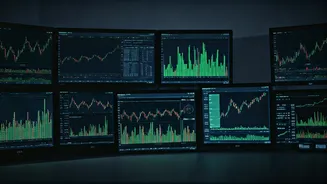Understanding the IT Boom
The remarkable surge in the Nifty IT Index indicates a robust performance within the Information Technology sector. Several elements contribute to this
upward trajectory, including positive market sentiment, increasing demand for technological solutions, and favorable financial outcomes reported by IT companies. The shift towards digital transformation is also a significant driver, with businesses across industries investing heavily in digital infrastructure, cloud computing, cybersecurity, and data analytics. This environment creates a conducive atmosphere for IT service providers to expand their operations and boost revenues. Furthermore, global economic conditions and currency fluctuations influence the IT sector's overall profitability. The Indian IT sector, which gains a major share of its revenue from exports, tends to benefit when the rupee weakens against the US dollar. This makes Indian IT services more competitive in the international market, driving up the earnings of these companies and subsequently boosting the Nifty IT Index.
Key Growth Drivers Analyzed
Several pivotal forces are propelling the growth of the Nifty IT Index. One crucial aspect is the continuous adoption of digital technologies by companies worldwide. As businesses aim to streamline their operations, improve customer experiences, and increase efficiency, they are progressively relying on IT solutions. This widespread digitization generates a constant demand for IT services and products, providing a solid foundation for the IT sector's growth. Another significant contributor is the outsourcing and offshoring trends. Many global corporations are choosing to outsource their IT functions to Indian IT firms due to the country's skilled workforce and cost-effectiveness. The increasing demand for cloud computing services is also having a beneficial impact on the IT index. With more companies transferring their data and applications to the cloud, the demand for cloud-based services such as infrastructure as a service (IaaS), platform as a service (PaaS), and software as a service (SaaS) is escalating. This is fueling growth within the IT sector and promoting an upward trend in the Nifty IT Index.
Investor Perspective and Strategy
The recent rally in the Nifty IT Index presents both opportunities and considerations for investors. Before deciding to invest, thorough research and understanding of the specific IT stocks are essential. Evaluate the financial health, growth potential, and market positioning of individual companies within the sector. It's also important to assess the risks associated with IT stocks, like the rapidly changing technological landscape and potential geopolitical concerns. A diversified investment strategy can help mitigate risk, including investing in a mix of IT stocks and spreading investments across various sectors. Investors should also monitor economic data, industry trends, and company-specific news to stay informed about developments affecting the IT sector. Maintaining a long-term investment horizon can be beneficial, as it allows investors to weather short-term market fluctuations and capitalize on the sector's long-term growth prospects. Consulting with a financial advisor can also provide personalized guidance based on individual financial goals and risk tolerance.
Evaluating Risks Involved
While the Nifty IT Index's growth is promising, potential investors must carefully assess associated risks. One major concern is the intense competition within the IT industry. Companies compete fiercely for projects, clients, and skilled professionals, which may impact profit margins and growth rates. Another critical risk factor is the rapid pace of technological advancements. IT companies must continuously adapt to new technologies to maintain relevance and competitiveness, requiring significant investments in research and development. Economic downturns and global uncertainties can also significantly affect the IT sector. A slowdown in economic activity can lead to decreased spending on IT services and products. Geopolitical issues, currency fluctuations, and changes in trade policies can also impact the profitability and operational performance of IT companies. Investors need to monitor these factors carefully and adjust their investment strategies accordingly. Diversifying the investment portfolio across various IT companies and sectors can also help in managing these risks effectively, and potentially capitalizing on opportunities.
Future Outlook and Forecast
The outlook for the Nifty IT Index seems optimistic, backed by long-term trends and factors. As the global digital transformation continues, demand for IT services and products is expected to keep growing, bolstering the sector's prospects. Emerging technologies, like artificial intelligence, machine learning, and Internet of Things (IoT), present new opportunities for IT companies to expand their offerings and create value. The Indian IT sector's advantages, including a skilled workforce, cost-effectiveness, and established infrastructure, position it favorably in the global market. However, the industry's evolution depends on the ability of IT companies to adapt, innovate, and meet evolving customer demands. Staying abreast of technological advancements, adapting to market changes, and continuously investing in talent development are vital for sustained growth. Investors should watch out for trends, evaluate companies and make well-informed decisions based on their financial goals and risk appetite. The future depends on navigating challenges and capitalizing on the opportunities that arise in this dynamic sector.















